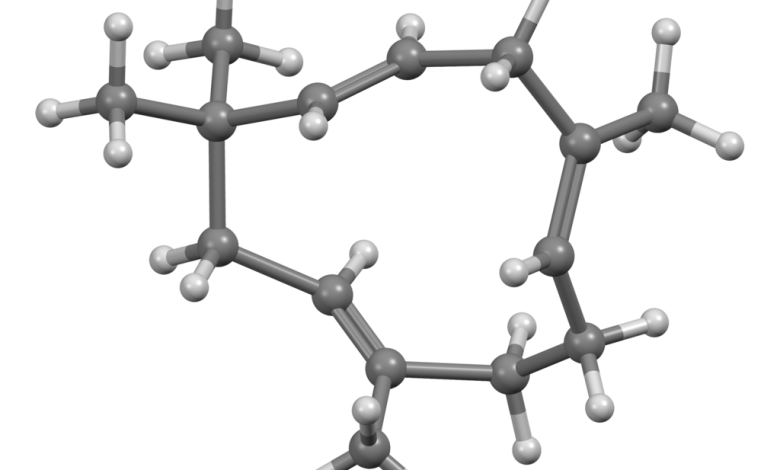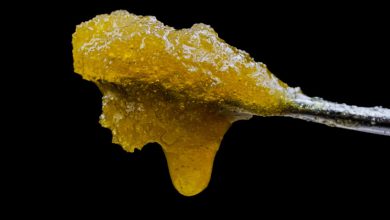Humulene, a terpene with many fans- Alchimia Grow Shop

What is Humulene?
- Name: Humulene, alpha-caryophyllene, alpha-humulene
- Formula: C15 H24
- IUPAC Name: 2,6,6,9-Tetramethyl-1,4-8-cycloundecatriene
- Molar mass: 204.35 g/mol
- Boiling point: 106 °C (379 K)
- Presence at room temperature: Clear, pale, greenish-yellow liquid
Cannabis plants are known throughout the world for their intense aroma, produced by the terpenes secreted in their glandular trichomes. Today we are going to talk about humulene, a monocyclic sesquiterpene with a very particular aroma and flavor that has a wide range of potential therapeutic benefits.
Often associated with its presence in hops, as it was first isolated from this plant (Humulus lupulus), this compound not only contributes to the characteristic aroma of many cannabis varieties but has also attracted the attention of researchers and patients due to its possible health effects. Join us and discover how humulene is produced, what its aroma and properties are, and which genetics tend to have a higher content of this unique sesquiterpenoid.
Humulene synthesis
As you already know, humulene can be found in some varieties of cannabis, giving them a very characteristic flavor and aroma that in recent years has captivated the palates of many users. Indeed, it is not uncommon to find high amounts of this terpene in varieties such as Sour Diesel, Girl Scout Cookies, or OG Kush, which have legions of followers all over the world. Furthermore, and since hops are also a plant with a high content of this compound, it is not uncommon to find nuances of humulene in another product with even more fans than marijuana: beer.
Like many other sesquiterpenoids, humulene is produced from another substance, in this case, farnesyl diphosphate or FPP, through the catalytic action of sesquiterpene-synthesizing enzymes, including cyclization reactions. In addition, there are several ways to synthesize this compound in the laboratory, such as the Corey synthesis, the McMurry synthesis, the Takahashi synthesis, the Suginome synthesis, or the Groot synthesis, each of them producing humulene after a series of different processes and chemical reactions.
Humulene is also known as alpha-humulene and alpha-caryophyllene, which is in turn an isomer of beta-caryophyllene. In fact, it is not uncommon to find both compounds (humulene and beta-caryophyllene) together in numerous varieties of aromatic plants.
Flavor, aroma, and applications of humulene
Surely in many descriptions of marijuana varieties, you have read that it has an earthy, woody, or spicy aroma or flavor. Well, one of the main responsibles for this type of nuance is humulene, which is indeed characterized by its earthy, woody, and spicy aroma, with subtle notes of herbs and moist earth. As for the flavor, it is usually bitter, with earthy, woody, and peppery nuances. In addition to being commonly found in plants such as hops or cannabis, as we already know, it is not uncommon to also find it in others such as sage, pine, tobacco, and cloves, among others.
Regarding its use, humulene has various applications in different industries:
- Cannabis and CBD products: Due to its presence in cannabis, humulene contributes to the terpene profile of cannabis varieties, which affects the aroma and flavor of different plants. In addition, it has been studied for its potential to modulate the effects of other cannabinoids such as THC and CBD in the so-called entourage effect. It can be found in various CBD products.
- Food industry: Humulene is used in the food industry as a flavoring and flavoring additive, especially in products such as beer and some seasoned foods. As you already know, it contributes greatly to the characteristic aroma of hops in beer brewing.
- Pharmaceutical industry: The potential of humulene in traditional and modern medicine has been investigated for years. Studies have been carried out on its possible anti-inflammatory, antioxidant, and analgesic properties, which could lead to its use in the formulation of medications.
- Cosmetics and perfumery: Due to its pleasant aroma and possible beneficial properties for the skin, humulene is used in the cosmetics and perfumery industry in the production of products such as creams, lotions, and perfumes.

Properties and effects of humulene
In the previous section, you have already seen that this terpene has interesting and promising beneficial properties, which continue to be investigated today to incorporate this compound into various therapies and treatments. These are some of them:
- Anti-inflammatory properties: There have been studies suggesting that humulene may have anti-inflammatory properties, which could help reduce inflammation in the body.
- Analgesic properties: Some research indicates that it could also have analgesic effects, meaning it could help in treatments related to pain relief.
- Antioxidant properties: Humulene has been observed to have antioxidant properties, that is, it can combat oxidative stress in the body by neutralizing free radicals.
- Possible anti-cancer activity: Some preliminary studies suggest that humulene may have anti-cancer activity by inhibiting the growth of cancer cells and promoting programmed cell death (apoptosis). However, more research is needed in this area.
- Anxiolytic effect: Humulene has been noted to have a calming and relaxing effect in some studies, which could have benefits in reducing anxiety and stress.
- Potential antimicrobial effect: It has been suggested that this compound could have antimicrobial properties, and could be useful as a tool to help combat certain types of bacteria and fungi.
As always, keep in mind that research into many of these properties and effects of humulene is still ongoing, as is the case with many other cannabinoids and terpenes in cannabis, and more scientific evidence is needed to fully confirm these benefits so they can be used in an effective and standardized manner in the field of professional medicine.

Cannabis varieties rich in humulene
In the world of cannabis, and if you are the least bit of a follower of its trends you may know, varieties rich in humulene have been capturing the interest of enthusiasts and consumers in recent years, not only for their distinctive aroma and flavor, but also for their possible therapeutic properties, which we have already seen previously.
Here is a list of varieties that tend to produce plants that are particularly rich in today’s terpene:
And if what you are interested in are auto-flowering seeds rich in humulene, here are some good options:
Happy harvest!
References:
- Chemistry of hop aroma in beer, Val Peacock, Max Deinzer
- A chemotaxonomic analysis of terpenoid variation in Cannabis, Karl W Hillig
- Medicinal properties of terpenes found in Cannabis sativa and Humulus lupulus, Tarmo Nuutinen
- Hemp (Cannabis sativa L., Kompolti cv.) and Hop (Humulus lupulus L., Chinook cv.) Essential Oil and Hydrolate: HS-GC-MS Chemical Investigation and Apoptotic Activity Evaluation , Elisa Ovidi, Valentina Laghezza Masci, Anna Rita Taddei , Jacopo Torresi, William Tomassi, Matteo Iannone, Antonio Tiezzi, Filippo Maggi, Stefania Garzoli
The articles published by Alchimiaweb, S.L. are reserved for adult clients only. We would like to remind our customers that cannabis seeds are not listed in the European Community catalogue. They are products intended for genetic conservation and collecting, in no case for cultivation. In some countries it is strictly forbidden to germinate cannabis seeds, other than those authorised by the European Union. We recommend our customers not to infringe the law in any way, we are not responsible for their use.




